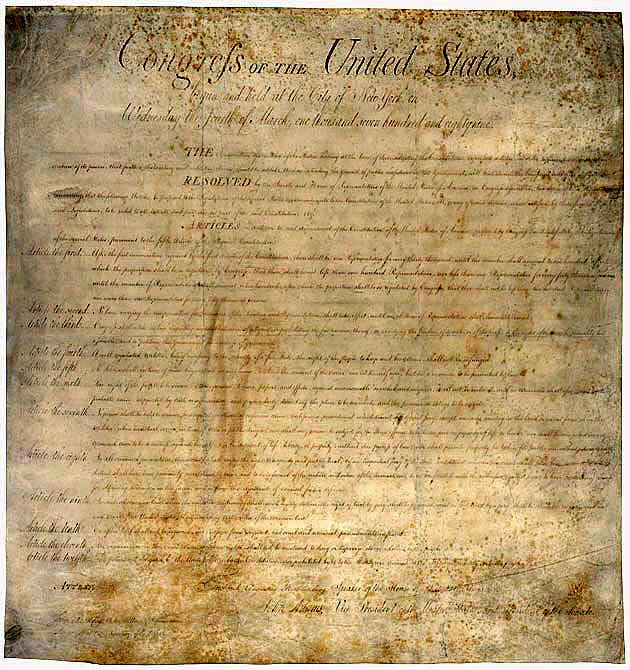Introduction of the Bill of Rights, 1795
Did you know the freedoms we hold most dear? Like, were free speech and religious liberty not originally part of the U.S. Constitution? That’s where the Bill of Rights comes in.
When the U.S. Constitution was ratified in 1788 many Americans feared it did not go far enough to protect individual liberties. The Bill of Rights was ratified just a few years later on December 15, 1791 and became the critical solution to that problem.
Let’s break down the bill of rights of the united states of america: definition for the bill of rights, what was the bill of rights, what is the bill of rights purpose, when was the bill of rights made, when was the bill of rights ratified, ten amendments of the bill of rights, who made the bill of rights (authors of the bill of rights), fact about the bill of rights, summarization of the bill of rights and why it matters, especially as it stood in 1795 just a few years after it was adopted and already shaping the American legal landscape.

Public domain image. The author died more than 70 years ago. Sourced via Wikimedia Commons. Original file.
What is the Bill of Rights?
Why did American colonists risk everything by dumping tea into Boston Harbor? They weren’t just protesting taxes but they were demanding rights. That bold act of defiance sparked a revolution that, years later, led to something even more powerful: the Bill of Rights.
So what is the Bill of Rights? The Bill of Rights is the first 10 amendments to the U.S. Constitution, written by James Madison who is known as the “Father of the Constitution” and who drafted the Bill of Rights. The Bill of Rights was ratified on December 15, 1791. These amendments were America’s answer to centuries of unchecked government power.
What did the people want? Clear, written protections. Freedom of speech. Freedom of religion. The right to protest. A free press. The right to bear arms. Fair trials. Due process. The Bill of Rights delivered all that and more.
By dumping tea into the harbor colonists sent a message: We will not be silenced. The Bill of Rights turned that message into law. It remains one of the most powerful documents ever written, protecting American freedoms to this day.
What is the Bill of Rights Purpose?
The Bill of Rights wasn’t just an add-on to the Constitution but it was a powerful act of defiance. Much like the Boston Tea Party where American colonists dumped tea into Boston Harbor to protest tyranny. The Bill of Rights emerged from deep-rooted fears of unchecked power.
After the Constitution was drafted, Anti-Federalists raised the alarm. Would this new government trample individual freedoms? Could it become just as oppressive as the British crown?
When was the Bill of Rights Passed?
In response James Madison took action. Drawing inspiration from the English Bill of Rights (1689) and various state constitutions. He proposed 12 amendments in 1789. By 1791 ten of these were ratified, Articles 3 through 12, forming the Bill of Rights.
The Bill of Rights Timeline:
- 1789: 12 amendments proposed.
- 1791: 10 ratified.
- 1795: Fully integrated into American legal life.
These amendments freedom of speech, religion, the right to bear arms and more set clear boundaries for government power. Just like the colonists at Boston Harbor Americans demanded liberty. The Bill of Rights was their declaration that freedom must be protected. Not promised.
What are the 10 Amendments on the Bill of Rights?
List of The Bill of Rights:
| Amendment of The Bill of Rights | Summary of The Bill of Rights |
| First Amendment of Bill of Rights | Freedom of religion, speech, press, assembly, and petition |
| 2nd Amendment to The Bill of Rights | Right to bear arms |
| 3 Amendment Bill of Rights | No quartering of soldiers in private homes during peacetime |
| 4 Amendment Bill of Rights | Protection from unreasonable searches and seizures |
| 5th Amendment of Bill of Rights | Right to due process, protection from self-incrimination and double jeopardy |
| 6th Amendment of Bill of Rights | Right to a speedy, public trial and impartial jury |
| 7 Amendment Bill of Rights | Right to a trial by jury in civil cases |
| 8 Amendment Bill of Rights | Protection from excessive bail, fines, and cruel and unusual punishment |
| 9th Amendment of Bill of Rights | Acknowledgment that people have rights beyond those listed in the Constitution |
| 10 Amendment of the bill of Rights | Powers not given to the federal government belong to the states or the people |
“The liberties of our country, the freedom of our civil constitution, are worth defending at all hazards.”
— Samuel Adams quote
The Bill of Rights in 1795: Still New, Already Powerful
Just as the Boston Tea Party was a bold act of defiance against British tyranny. The Bill of Rights was a powerful answer to American fears of government overreach. Ratified in 1791 and already influential by 1795 these first ten amendments were not just symbolic but they were becoming the backbone of American liberty.
By 1795 legal debates across the states began referencing these rights. Judges, lawyers and everyday citizens leaned on them to challenge federal policies and protect individual freedoms and The Bill of Rights became more than parchment. It was a promise.
In the same spirit that drove colonists to dump tea into Boston Harbor in 1773. Americans now use these rights as a shield. Just as patriots protested unjust taxation, citizens in the new republic stood up against unchecked power.
The colonists had hoped to secure a voice, fair laws and a government that listened. The Bill of Rights delivered that hope in writing and by 1795 it was already delivering results in courtrooms and public squares.
Some key highlights of its early influence:
- Legal debates started referencing constitutional rights
- Public discourse leaned on these amendments to argue for or against federal policies
- States and citizens increasingly viewed the Bill of Rights as a shield against government overreach
Freedom was no longer a dream but it was a right.
Why is The Bill of Rights Important?
In the spirit of defiance that sparked the Boston Tea Party and the Bill of Rights was born from a deep desire for freedom and protection against tyranny. Just as colonists dumped tea into Boston Harbor to protest unfair control. Americans today rely on the Bill of Rights to guard their most fundamental freedoms.
So why does the Bill of Rights still matter today?
What is the Importance of the Bill of Rights?
- You can speak freely even on controversial topics online
- You can worship or not as you choose. Without fear
- You’re protected from unwarranted government intrusion ensuring your privacy matters
These ten amendments aren’t just old parchment but they’re active shields in today’s debates about social media speech, gun rights and digital privacy.
When the colonists rebelled they weren’t just angry about taxes but they wanted a say, protection and respect. The Bill of Rights delivered that promise and centuries later. It’s still defending it.
From Boston Harbor to today’s headlines the fight for freedom lives on.
Let’s never take these rights for granted.
Final Thought: Importance of the Bill of Rights
Even though it was ratified in 1791 and still fresh in 1795. The Bill of Rights remains one of the most powerful statements of liberty in the world. It’s more than law. It’s a promise. One that’s been debated, defended and defined by every generation since.


